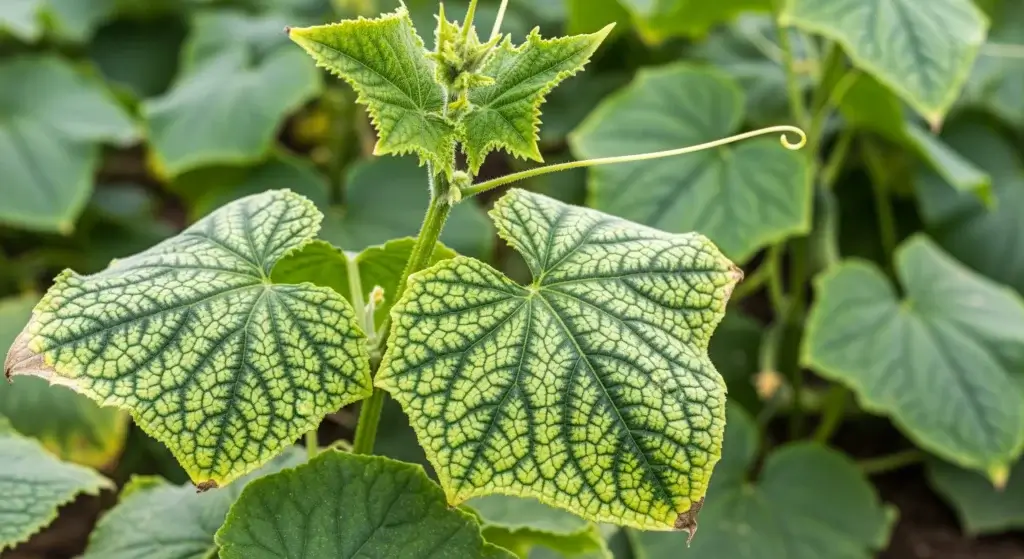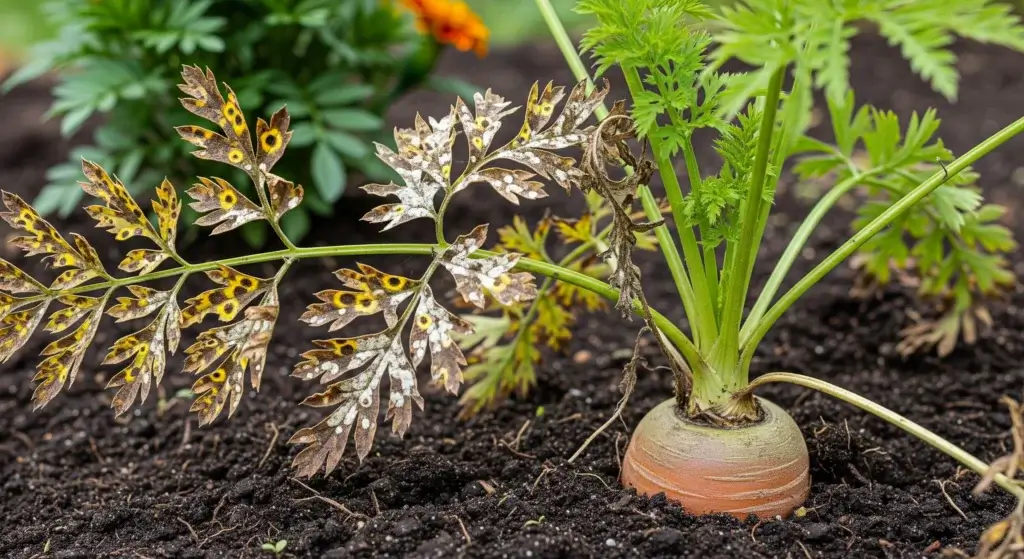
Onion white rot is a major threat to onion growers worldwide.
Caused by the soil-borne fungus Sclerotium cepivorum, this disease can devastate onion crops, affecting yields and causing significant economic losses.
Once it establishes in the soil, managing and controlling it becomes a difficult task.
In this article, we’ll explore the symptoms of onion white rot, the damages it causes, and the most effective strategies for controlling and managing the disease.
By understanding how to prevent and combat onion white rot, farmers can protect their crops and ensure a successful harvest.
Symptoms of Onion White Rot
Detecting onion white rot early is crucial for managing the disease effectively.
This condition primarily impacts the roots and the base of onion plants, leading to several noticeable symptoms:
Yellowing and wilting of leaves
One of the first signs of onion white rot is the yellowing of leaves.
You may notice that some leaves turn yellow unevenly.
This yellowing is often followed by wilting, especially during hot weather, making the plant look weak and unhealthy.
- Read also: A Comprehensive Guide: Strategies for Onion Maggot Control
- Read also: Symptoms and Solutions: Understanding Onion Fly Damage
Soft bulbs and decay
Infected onion bulbs will start to feel soft and may show signs of decay.
This happens because the fungus attacks the base of the plant and spreads upward, causing the plant’s tissues to break down.
As a result, the bulbs lose their firmness and become unappetizing.
White fungal growth
A clear indicator of onion white rot is the appearance of a white, fluffy fungal growth at the base of the bulb.
You might also see small black structures known as sclerotia, which are the survival structures of the fungus.
These are a sign that the fungus is thriving in the onion.
Stunted growth
As the infection worsens, the affected plants may exhibit stunted growth.
This occurs because the roots are damaged and struggle to absorb nutrients properly.
If the disease isn’t controlled, the plants may eventually die.
According to research published in the Journal of Plant Pathology (2023), onion white rot can reduce crop yield by up to 60% if not managed properly.
Therefore, understanding these symptoms and acting quickly is crucial for minimizing damage.

Damages of Onion White Rot
Onion white rot can have serious consequences for crops, affecting farmers in several ways:
Reduced yield
When plants are infected, they often fail to produce bulbs that are good enough for sale.
This leads to lower overall yields and financial losses for farmers, as they cannot harvest enough marketable onions.
Soil contamination:
The fungus responsible for onion white rot can linger in the soil for many years—sometimes up to 15 years or more.
It does this by creating sclerotia, which can survive even in tough conditions.
This makes it risky to replant onions or other related crops (like garlic and leeks) in affected fields, as the fungus may still be present.
Quality deterioration
Even if some infected onions make it to harvest, they usually suffer from poor quality.
The disease causes the bulbs to soften and decay, making them less desirable for consumers and less valuable for farmers.
Economic impact:
The financial losses from onion white rot can be significant.
In severe cases, farmers may have to abandon entire fields or wait many years before they can safely grow onions again in the same area.
Control Measures
Controlling onion white rot requires a multi-faceted approach that combines cultural practices, resistant varieties, and both chemical and biological controls.
Here’s how farmers can manage the disease effectively:
Cultural practices
Cultural practices play an essential role in preventing and managing onion white rot.
Here are some effective strategies:
Crop rotation
Rotating onion crops with non-host plants, such as cereals or legumes, for several years can significantly reduce the amount of sclerotia (the fungal survival structures) in the soil.
This is important because the fungus specifically targets allium crops like onions, garlic, and leeks.
By planting different types of crops, you can break the cycle of infection.
Soil solarization
This method involves using clear plastic sheets to trap heat from the sun in the soil.
By raising soil temperatures above 45°C (113°F) for several weeks, you can effectively kill a large percentage of sclerotia.
Soil solarization is a practical and eco-friendly way to reduce fungal populations before planting onions.
Sanitation
Keeping tools, machinery, and footwear clean is crucial in preventing the spread of the fungus.
Before moving between fields, make sure to wash off any soil or plant debris that may carry the disease.
This step helps to ensure that contaminated materials do not transfer from infected areas to healthy ones.
Resistant onion varieties
Growing onion varieties that are resistant to white rot is an effective strategy for managing this disease.
Here are some key approaches:
Selection of resistant cultivars
While no onion varieties are completely immune to white rot, some show partial resistance to the disease.
Ongoing research aims to identify and develop these resistant varieties, giving farmers more options for planting.
Choosing these cultivars can help reduce the impact of white rot on their crops.
Use of certified disease-free seeds and bulbs
Starting with clean planting material is crucial for preventing the introduction of the fungus into the field.
By purchasing certified disease-free seeds and bulbs, farmers can significantly lower the initial risk of white rot.
This proactive step helps ensure a healthier crop from the beginning.

Chemical control
Using chemicals can be an effective way to manage onion white rot, but it’s important to use them carefully.
Here are some options:
Fungicides
Fungicides with active ingredients like tebuconazole and fludioxonil have proven to be effective against onion white rot.
These chemicals can be applied to the soil before planting or as seed treatments to help protect young plants from infection.
Sulfur treatments
Sulfur-based products can also help reduce fungal activity when applied to the soil.
However, it’s crucial to follow the recommended application guidelines to ensure effectiveness.
Additionally, rotating different chemicals is important to prevent the fungus from developing resistance.
Biological control
Biological control methods provide a sustainable way to manage onion white rot without relying solely on chemicals.
Here are some effective approaches:
Biofungicides
Biofungicides containing beneficial microbes, like species from the Trichoderma genus, can help fight against Sclerotium cepivorum, the fungus responsible for white rot.
These products work by creating a competitive environment in the soil, making it harder for the white rot to establish itself.
Organic matter management
Adding compost and other organic materials to the soil can boost the diversity of beneficial microbes.
This increased microbial activity helps naturally suppress the pathogen.
Plus, organic matter improves the soil structure, making it less favorable for the fungus to thrive.
Integrated pest management (IPM)
Integrated Pest Management (IPM) offers a well-rounded approach to controlling onion white rot by combining multiple strategies:
Monitoring and early detection
Regularly checking fields for early signs of white rot is crucial.
This proactive approach allows farmers to act quickly, reducing the chances of the disease spreading.
Combining cultural, chemical, and biological controls
By using a mix of different practices—such as crop rotation, soil solarization, biofungicides, and careful application of fungicides—farmers can create a strong defense against onion white rot.
This integrated strategy maximizes effectiveness while minimizing reliance on any single method.
Field mapping and planning
Keeping detailed records of areas affected by white rot helps farmers plan better for the future.
By mapping out infected zones and organizing crop rotations accordingly, they can reduce the impact of the disease over time.

- Read also: Top Strategies for Preventing Onion Downy Mildew
- Read also: Eco-Friendly Pest Control – How To Make a Natural Pesticide
Final Thoughts
Onion white rot is a serious challenge for onion growers, but with a combination of early detection, cultural practices, and modern control methods, it is manageable.
Implementing an integrated approach that includes resistant varieties, proper sanitation, and a mix of chemical and biological treatments can significantly reduce the impact of this persistent fungus.
Farmers who adopt these strategies can protect their crops and achieve better yields, even in areas where onion white rot is prevalent.
FAQs
No, onion white rot specifically targets allium crops such as onions, garlic, and leeks. It does not affect other types of vegetables or cereals.
The sclerotia of the fungus can survive in the soil for up to 15 years or more, making it a long-term challenge for affected fields.
While chemical control can reduce the spread of the disease, it is most effective when combined with cultural and biological methods as part of an integrated pest management approach.
No onion varieties are completely resistant to white rot, but some show partial resistance. It’s important to choose certified disease-free planting materials to reduce the risk of infection.



